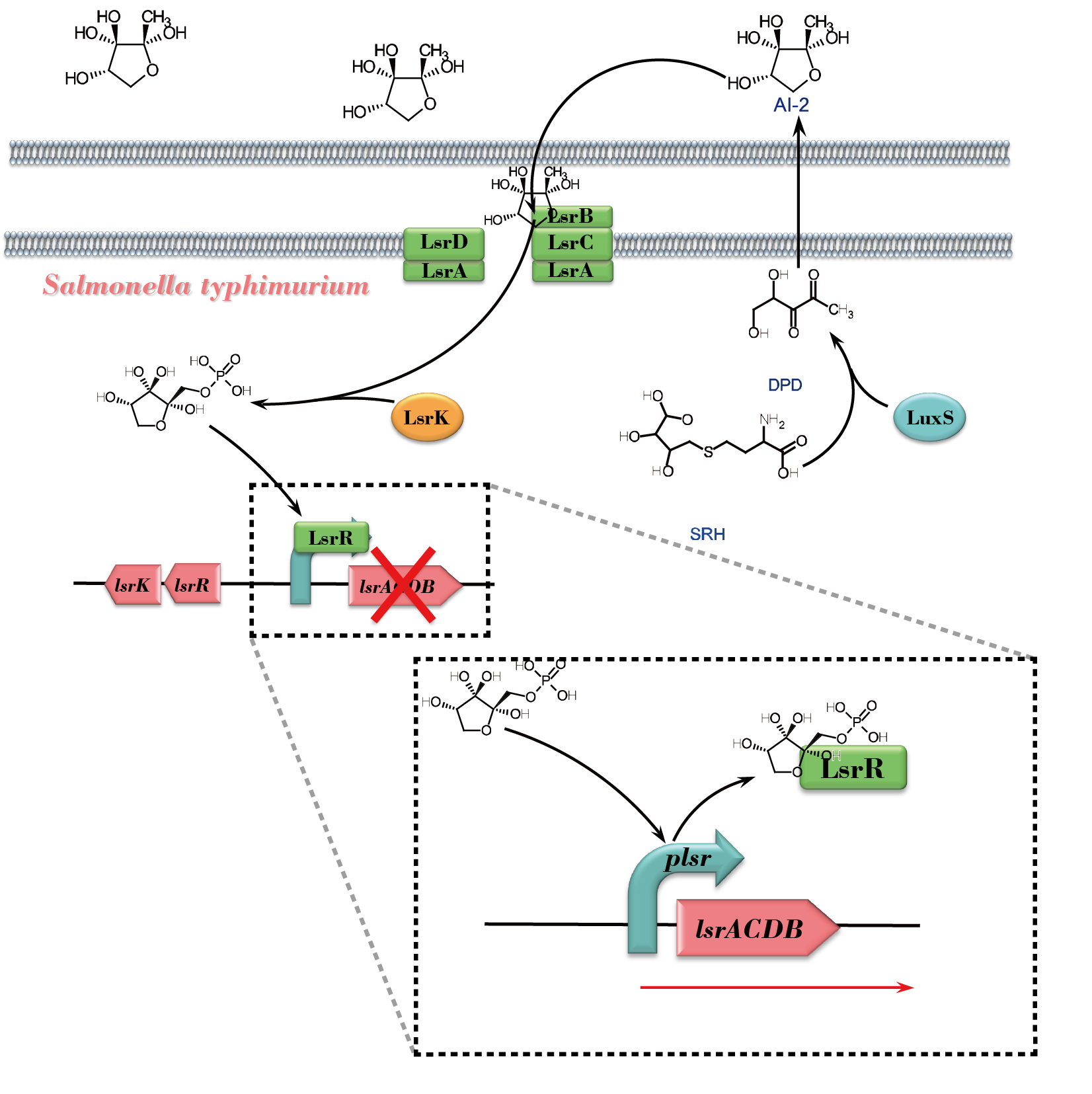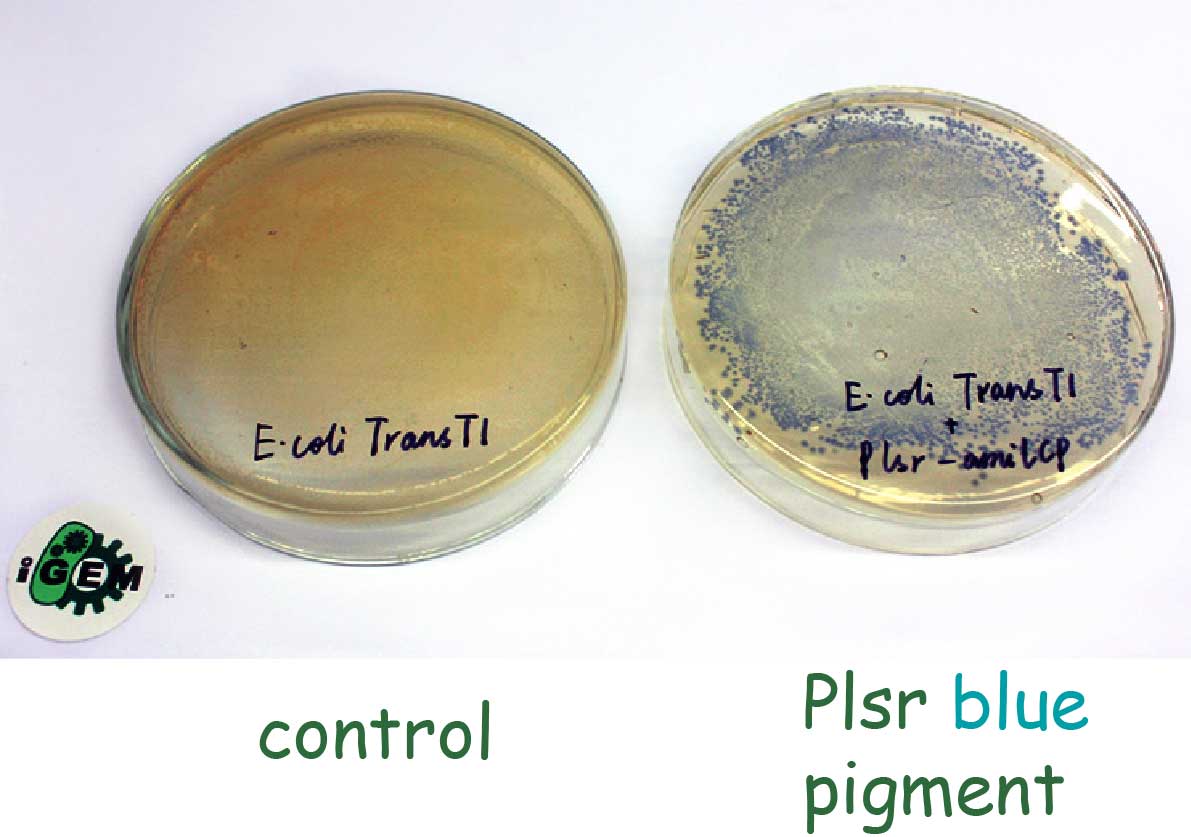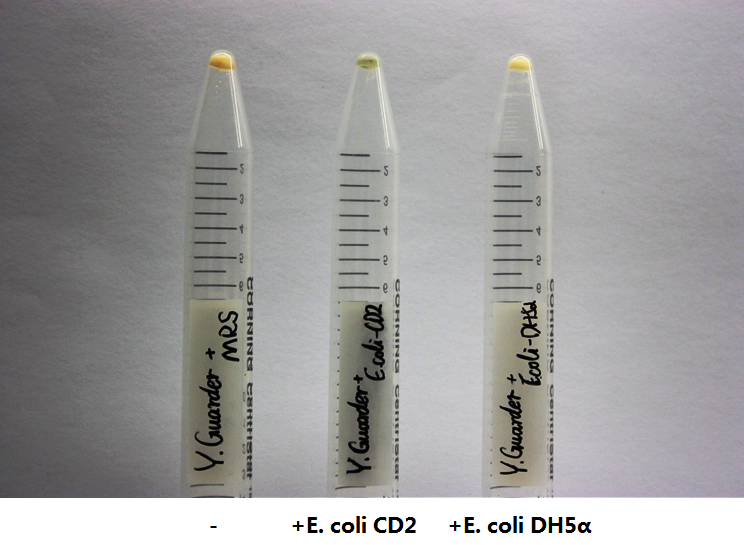Difference between revisions of "Part:BBa K1666005"
| Line 1: | Line 1: | ||
| − | |||
__NOTOC__ | __NOTOC__ | ||
<partinfo>BBa_K1666005 short</partinfo> | <partinfo>BBa_K1666005 short</partinfo> | ||
| Line 5: | Line 4: | ||
Quorum sensing is a process of bacterial cell-to-cell communication involving the production and detection of extracellular signaling molecules called autoinducers. And autoinducer-2 (AI-2) has been proposed to serve as a 'universal signal' for interspecies communication. In the LuxS/AI-2 signaling system of Salmonella Typhimurium, AI-2 response involves ATP binding cassette transporter encoded by genes named Lsr (LuxS regulated). And LsrR is the Transcriptional regulator which is inactivated by binding phospho-AI-2, leading to the transcription of the lsr genes. In our project, we set this protein-coding part under a nisA promoter and try to integrate them in the genome of Lactobacillus or Lactococcus for the final purpose of constructing an integrated AI-2 response pathway of Salmonella in the engineered bacteria. | Quorum sensing is a process of bacterial cell-to-cell communication involving the production and detection of extracellular signaling molecules called autoinducers. And autoinducer-2 (AI-2) has been proposed to serve as a 'universal signal' for interspecies communication. In the LuxS/AI-2 signaling system of Salmonella Typhimurium, AI-2 response involves ATP binding cassette transporter encoded by genes named Lsr (LuxS regulated). And LsrR is the Transcriptional regulator which is inactivated by binding phospho-AI-2, leading to the transcription of the lsr genes. In our project, we set this protein-coding part under a nisA promoter and try to integrate them in the genome of Lactobacillus or Lactococcus for the final purpose of constructing an integrated AI-2 response pathway of Salmonella in the engineered bacteria. | ||
| − | |||
===Usage and Biology=== | ===Usage and Biology=== | ||
| + | AI-2 is generated by many species of Gram-negative and Gram-positive bacteria. In a group of bacteria exemplified by ''Salmonella'', AI-2 response involves ''lsr'' genes that encode ATP binding cassette-type transporter. In the absence of autoinducer 2 (AI-2), LsrR represses transcription of the ''lsr'' operon and itself. Phospho-AI-2 can bind LsrR and inactivate it through releasing it from the repressed promoters, leading to the transcription of the lsr genes. | ||
| + | |||
| + | [[File:NEFU_China_2015_AI-2_response_in_Salmonalla.png|550px|thumb|center|'''Fig1. Schematic overview of the AI-2 response pathway in ''Salmonella Typhimurium'''''The precursor of AI-2, 4,5-Dihydroxy-2,3-Pentanedione (DPD) , is a byproduct generated when LuxS converts S-Ribosylhomocysteine (SRH) to Homocysteine (HCY). DPD then undergoes spontaneously cyclization, forming AI-2, and exports to the culture supernatant. After that, extracellular AI-2 bounds to LsrB, following by passing the membrane channel and importing the cytoplasm. LsrK phosphorylates AI-2 afterwards. The ''lsr'' operon is repressed until phosphorylated AI-2 causes LsrR to relieve its repression on the promoter. And this allows further AI-2 import.]] | ||
| + | |||
| + | In our project, we set this protein-coding part under the regulation of a nisA promoter which can be activated by food-grade inducer, nisin. We linearized the related expression vectors and stably integrated them into the genome of the hosts. And together with other parts, we will construct a response pathway for AI-2 generated by pathogens in the engineered bacteria. | ||
| + | |||
| + | ===Characterization=== | ||
| + | |||
| + | We transformed the plasmid pHY300PLK containing P''lsr'' with a blue pigment gene at its downstream into ''E. coli'' Trans T1. | ||
| + | As we can see, after overnight incubation, we observed blue colonies on the plate. That means without LsrR-mediated repression, the P''lsr'' promoter will be constitutively active and promote the production of visible blue pigment. | ||
| + | |||
| + | [[File:NEFU_China_2015_Ecoli_Blue.png|500px|thumb|center|'''Fig3. Engineered ''E. coli'' Trans T1 contains pHY300PLK-P''lsr''-''amilCP'' ''']] | ||
| + | |||
| + | After we have successfully integrated pNZ9530 and the expression vectors for ''lsrB'', ''R'' and ''K'' into the ''Lactobacillus'' genome, we sequentially transformed the P''lsr''-''amilCP'' vector. | ||
| + | We cultured our engineered ''Lactobacillus'' in the medium containing AI-2 secreted by ''E. coli'' CD-2. We used DH5alpha bacteria as a control because they do not produce any AI-2. Our engineered ''Lactobacillus'' showed clear blue color compared to the control. | ||
| + | Without AI-2, the engineered bacteria did not generate blue pigment due to the repression of LsrR. The result strongly indicated that LsrR functions as expected. | ||
| + | [[File:NEFU_China_2015_Yogurt_Blue.png|500px|thumb|center|'''Fig4. Engineered ''Lactobacillus'' incubated with culture supernatant of different bacteria ''']] | ||
<!-- --> | <!-- --> | ||
<span class='h3bb'>Sequence and Features</span> | <span class='h3bb'>Sequence and Features</span> | ||
Revision as of 03:36, 19 September 2015
LsrR of LuxS/AI-2 signaling pathway in Salmonalla
Quorum sensing is a process of bacterial cell-to-cell communication involving the production and detection of extracellular signaling molecules called autoinducers. And autoinducer-2 (AI-2) has been proposed to serve as a 'universal signal' for interspecies communication. In the LuxS/AI-2 signaling system of Salmonella Typhimurium, AI-2 response involves ATP binding cassette transporter encoded by genes named Lsr (LuxS regulated). And LsrR is the Transcriptional regulator which is inactivated by binding phospho-AI-2, leading to the transcription of the lsr genes. In our project, we set this protein-coding part under a nisA promoter and try to integrate them in the genome of Lactobacillus or Lactococcus for the final purpose of constructing an integrated AI-2 response pathway of Salmonella in the engineered bacteria.
Usage and Biology
AI-2 is generated by many species of Gram-negative and Gram-positive bacteria. In a group of bacteria exemplified by Salmonella, AI-2 response involves lsr genes that encode ATP binding cassette-type transporter. In the absence of autoinducer 2 (AI-2), LsrR represses transcription of the lsr operon and itself. Phospho-AI-2 can bind LsrR and inactivate it through releasing it from the repressed promoters, leading to the transcription of the lsr genes.

In our project, we set this protein-coding part under the regulation of a nisA promoter which can be activated by food-grade inducer, nisin. We linearized the related expression vectors and stably integrated them into the genome of the hosts. And together with other parts, we will construct a response pathway for AI-2 generated by pathogens in the engineered bacteria.
Characterization
We transformed the plasmid pHY300PLK containing Plsr with a blue pigment gene at its downstream into E. coli Trans T1. As we can see, after overnight incubation, we observed blue colonies on the plate. That means without LsrR-mediated repression, the Plsr promoter will be constitutively active and promote the production of visible blue pigment.
After we have successfully integrated pNZ9530 and the expression vectors for lsrB, R and K into the Lactobacillus genome, we sequentially transformed the Plsr-amilCP vector. We cultured our engineered Lactobacillus in the medium containing AI-2 secreted by E. coli CD-2. We used DH5alpha bacteria as a control because they do not produce any AI-2. Our engineered Lactobacillus showed clear blue color compared to the control. Without AI-2, the engineered bacteria did not generate blue pigment due to the repression of LsrR. The result strongly indicated that LsrR functions as expected.
Sequence and Features
- 10COMPATIBLE WITH RFC[10]
- 12COMPATIBLE WITH RFC[12]
- 21COMPATIBLE WITH RFC[21]
- 23COMPATIBLE WITH RFC[23]
- 25INCOMPATIBLE WITH RFC[25]Illegal NgoMIV site found at 267
Illegal NgoMIV site found at 844 - 1000INCOMPATIBLE WITH RFC[1000]Illegal SapI.rc site found at 43


